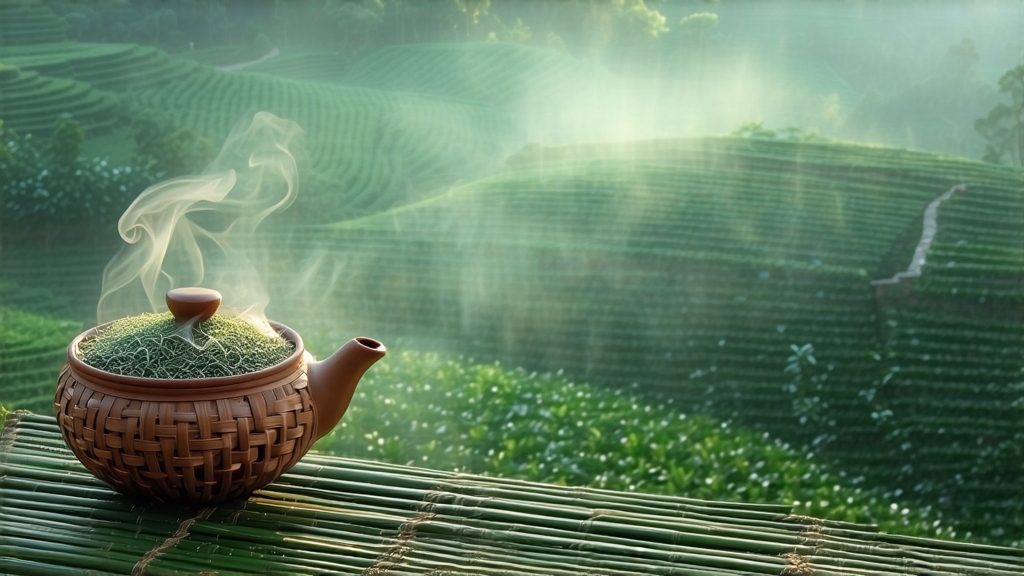
Biluochun, whose name translates literally to “Green Snail Spring,” is one of China’s ten most celebrated teas, yet it remains a quiet mystery outside the circles of serious tea lovers. Grown on the mist-locked, fruit-tree-dotted hills that rise from the eastern shore of Taihu Lake in Jiangsu Province, this jade-green pearl carries within its tight spiral the perfume of apricot blossoms, the minerality of granite soils, and the patience of artisans who still shape every leaf by hand. To understand Biluochun is to step into a microclimate where lake, mountain, orchard, and human intention converge; to taste it is to witness how geography can be folded into flavor.
Historical whispers place Biluochun’s birth in the late Kangxi period of the Qing dynasty. Legend claims that a tea-picking girl, startled by the sudden appearance of a serpentine creature, dropped her entire basket of fresh leaves into the undergrowth. Overnight the leaves absorbed the fragrance of nearby fruit trees; when the local monks brewed them the next morning, the liquor astonished everyone with its natural sweetness and floral lift. The emperor, visiting Suzhou in 1699, declared the tea “Xia Sha Ren Xiang”—literally “scary fragrance”—because its aroma was almost too exquisite to believe. Later court scholars softened the name to Biluochun, evoking both the snail-like curl and the season of earliest spring.
Strictly speaking, only leaf plucked within the Dongting Dongshan and Xishan peninsulas can claim the protected designation “Original Biluochun.” Here, the lake acts as a gigantic heat reservoir, moderating winter cold and shrouding the terraces in vapor until mid-morning. The same humidity forces tea bushes to grow slowly, concentrating amino acids and fragrant compounds. Farmers interplant their gardens with peach, plum, loquat, and pomegranate; petals fall onto the bushes, and bees shuttle between blossom and leaf, adding invisible layers of scent that later emerge in the cup. Outside this core zone, similar-looking teas are sold as “Suzhou Biluochun” or simply “spiral green,” but insiders insist the original terroir is irreplaceable.
Plucking begins when the meteorological spring starts—usually between March 15 and April 10—on days when overnight temperatures stay above 5 °C and buds are still closed tight as needles. Only the “one bud with one unfolding leaf” standard is accepted; anything larger is diverted to cheaper grades. An experienced picker gathers barely 500 grams of fresh leaf in a full day, enough to yield just 100 grams of finished tea. Speed matters because once picked, the buds begin to respire and lose their delicate bouquet. Baskets are carried down the hillside within two hours to the village workshop, where the real alchemy begins.
Biluochun is the archetype of the “pan-fire” green tea family, yet its craft is gentler than that of Longjing or Taiping Houkui. The goal is to arrest oxidation while preserving downy hairs and internal juices that will later release sweetness. First, the leaves are spread in bamboo trays no thicker than two centimeters and withered under soft lake breezes for thirty to forty minutes. Water content drops from 76 % to roughly 68 %, enough to make the bud pliable without wilting. Master craftsmen then load three kilograms of leaf into a wok heated to 180 °C, tossing and pressing with bare hands in a motion called “tui ya.” Fingers act as both thermometer and timer; when the leaf temperature reaches 65 °C, enzymes denature and the grassy odor gives way to a chestnut note. The entire kill-green stage lasts only four minutes, after which the leaves are transferred to a second wok held at 70 °C for initial shaping.
Shaping is where Biluochun earns its name. Artisans rub tiny handfuls of hot leaf against the wok surface using three fingers—thumb, index, and middle—curling the bud into a tight spiral while simultaneously drying it. Each spiral must contain exactly 6–8 tiny hairs visible under a 10× loupe; fewer means over-handling, more means under-fixation. The motion looks like calligraphy: wrist lifted, elbow anchored, breath steady. After thirty minutes the leaf moisture falls to 20 %, and the spirals hold their form. A final low-temperature bake at 50 °C for twenty minutes drives residual water down to 5 %, locking in fragrance. When complete, 100 grams of finished tea contain roughly 15,000 individual spir